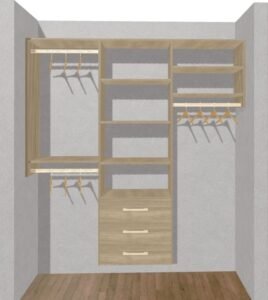The presentation is at the core of the order-getting selling process and its objective is to convert a prospect into a customer by creating a desire for the product or service. A few different formats of presentation exist; however, in the closet industry you are best to focus on the Need-Satisfaction Format of presenting. This format emphasizes probing and listening by the salesperson to identify the needs and interests of prospective buyers. Once these are identified, the salesperson tailors the presentation to the prospect and highlights product benefits. The need-satisfaction format, which emphasizes problem solving, is the most consistent with the marketing concept and relationship building. Two selling styles are associated with this format.
- Adaptive Selling involves adjusting the presentation to fit the selling situation, such as knowing when to offer solutions and when to ask for more information
- Consultative Selling focuses on problem identification where the salesperson serves as an expert on problem recognition and resolution.
These two selling styles personalize the selling process by identifying the customers needs and focusing on the benefits that directly meet those needs. The following sections take you through the main parts of the presentation once the approach has been made.
Note: At all times during the sales presentation use the sales aids that assist the customer in understanding the features and benefits of ownership. This may include, but are not limited to, the Sales Kit, color samples, accessories brochure, using your design software to create 2D and 3D views, etc.
Once you have measured all the areas the customer wants organized, use the adaptive and consultative selling techniques to design the most efficient system. An effective tool during this process is the Designer Cards provided by Sherwood Shelving. Once a design has been approved, record the design on the floor plan indicating the style of section the customer wants and if necessary, the approximate size. For example, let’s say you have a simple 6-foot wall closet. The customer has approved the following design:

With the above design in mind record this on your floor plan, “DH”, “6FT TWR-3M”, and “LH”. Now move on to the next closet design and repeat the process until all the closets in the house have been designed and approved by the customer. For each closet design make sure to present the features and benefits of the Sherwood Shelving™ system. Note that the “3M” stands for 3 medium drawers.
Quoting the price is a critical step in the sale. Each customer is unique in price sensitivity and certainly each designer has his/her comfort zone in this area. It is important to keep in mind that price is not always the determining factor in the consumer decision making process. Do not show fear or apprehension when quoting. A good designer/salesperson will quote positively and enthusiastically. By doing this you demonstrate that your price is fair and the product is worth it.
The cost estimate is given to the customer after a full presentation and material selection has been made. However, a rough estimate given while measuring the closet can help to eliminate any possible negative reaction early in the presentation.
Tip: It is helpful to ask the customer at the begining what thier budget is. Don’t underestimate the price. It is better to be a bit on the high end than to surprise the customer with a higher final price. Try quoting the cost in a way that requires a positive customer response. If the customer objects to price, suggest he/she eliminate some of the accessories you may have proposed in the plan. Tell the customer these items can always be added later. If the customer still objects suggest some design changes that would reduce the price of the closet and bring the price more in line with what the customer was expecting to pay.
Many customers raise objections because of dollar cost, resistance to change or fear of making a decision. You will hear them all. The following are some suggestions for overcoming objections:
- Listen and validate
- Answer truthfully and objectively
- Clearly identify the major objection
The following are some examples of common concerns and suggested responses:
- “Yes, in relation to the system you currently have it may seem expensive.” Now identify how much too expensive it is. “Mrs. Jones, how much did you plan on spending for your new closet system?” The price objection may be much less than the actual cost of what you anticipated and from that basis you can proceed accordingly. At this point it is important to address value in relation to customer needs and benefits.
- “I know how you feel. Some of my previous customers have felt the same way. However, they found that the extra investment was worthwhile in terms of how it organized the wardrobe and utilized available space.”
- “I know how you feel. You probably felt the same when you bought your microwave, refrigerator, washer or dryer. Have you found the extra dollars spent were worth while?”
- “How long will you be in the house? This closet system is an investment. If you look at the cost of the closet over five years it is just pennies a day. Think of how much storage space this system will create for you. You can always take the closet system with you when you sell the house or use it as a resale feature. It’s an investment in yourself and your future. The benefits are realized daily.”
- I know you are pleased with the design and anxious to have your closet installed. Let’s go ahead and tentatively book your installation. You can review the design and cost with your partner and if they have any concerns or changes just give me a call.
- Leave envelope for deposit or suggest calling in a credit card number to the store. This is a great time to let them know what we’ve learned about husbands and closets – they’re usually less enthusiastic about closets at first but once its installed they usually love the closet system. Why? Because they don’t normally have as much time invested in the closet and quite often their clothes are crammed in the back of the closet anyway. They as a rule prefer to be involved in the purchase of a stereo, TV, computer equipment, the family car and sports equipment.
- Point out to the wife that this may be the time that she’ll want to make a decision based on her needs. Give her the confidence she needs to make the decision on her own.
- Point out that yes, there are other systems on the market at various prices, however we’ve researched our competition. Many closet companies use 5/8” thick shelving that will usually sag within a very short period. Point out that your system uses absolutely the best furniture board available on the market and it is 3/4” thick and has a durable melamine finish. Giving the customer an example helps reinforce this feature. “You may have seen the shelving offered at high volume discount stores, this shelving is 5/8” thick and will sag in a short period of time. Also, when you look at the white shelving that they sell, it has a yellow hue to it. This is because the finish is so thin that you are actually seeing the wood through it. Our shelving uses a high-quality laminate and that is why even our white colored melamine is a really bright white.”
- Point out that we can bring our customers not only the best product and features, but also give them the lowest cost vs. quality and value.
The closing stage in the selling process involves obtaining a purchase commitment from the prospect. This stage is the most important and the most difficult because the salesperson must determine when the prospect is ready to buy. Telltale signs indicating a readiness to buy include body language (prospect re-examines the product or contract closely), statements (“This organizer will save me from a lot of clutter”), and questions (“When could we expect delivery?”).
Note: Address only the benefits of our system as opposed to making any negative comments about the competition. If you can’t close the sale at your initial appointment, inform the customer that they may contact you at any time if they have further questions after comparing other systems because you really would like to be sure they are getting the best value for their money.
It is our experience that making an appointment for the customer to see the quote at your office, and then being able to have them see, touch, and experience your showroom organizers, really helps to close the sale.


